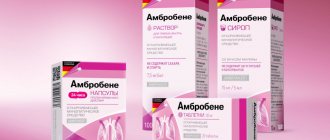Orungal®
— Effect on cardiac activity: in a study of the dosage form of the drug Orungal® for intravenous administration, a transient asymptomatic decrease in the left ventricular ejection fraction was noted, which normalized until the next infusion of the drug. The clinical significance of these data for oral dosage forms is unknown.
Itraconazole has a negative inotropic effect. Cases of chronic heart failure associated with taking Orungal® have been reported. At a daily dose of 400 mg of itraconazole, an increased incidence of heart failure was observed; at lower daily doses such a pattern was not revealed. The risk of chronic heart failure is presumably proportional to the daily dose. The drug Orungal® should not be taken by patients with chronic heart failure or with a history of this symptom complex, except in cases where the possible benefit significantly outweighs the potential risk.
When individually assessing the balance of benefit and risk, factors such as the severity of the indications, dosage regimen and individual risk factors for heart failure (coronary heart disease, valvular disease, obstructive pulmonary disease, renal failure and other diseases accompanied by edema) should be taken into account. Such patients should be informed about the signs and symptoms of chronic heart failure and monitored for their occurrence during the course of treatment. If such signs appear, taking Orungal® should be stopped.
Life-threatening cardiac arrhythmias and/or sudden death have been reported in patients receiving methadone concomitantly.
- Drug interactions: Concomitant use of certain drugs with itraconazole may result in changes in the effectiveness of itraconazole and/or concomitant drugs, life-threatening adverse reactions and/or sudden death. Drugs that cannot be taken concomitantly with itraconazole, are not recommended for concomitant use and/or are recommended for concomitant use with itraconazole with caution are listed in the section "Interactions with other drugs".
- Cross-hypersensitivity: Data regarding the presence of cross-hypersensitivity between itraconazole and other antifungals with an azole structure (from the azole group) are limited. If hypersensitivity to other azoles is present, itraconazole should be prescribed with caution.
— Interchangeability: interchangeable use of Orungal®, capsules, and Orungal®, oral solution is not recommended, due to the fact that the exposure of itraconazole is higher when used in the form of an oral solution than in capsule form, even when taking the same doses of itraconazole .
- Reduced acidity of gastric juice: with reduced acidity of gastric juice, the absorption of itraconazole from capsules is impaired. Patients with reduced gastric acidity due to illness (for example, patients with achlorhydria) or due to medications (for example, drugs that suppress gastric secretions), it is recommended to take Orungal® capsules simultaneously with acidic drinks (such as non-diet cola). The antifungal activity of the drug should be monitored and the dose of itraconazole should be increased if necessary.
- Effect on liver function: in very rare cases, severe toxic liver damage has developed when using the drug Orungal®, including several cases of acute liver failure with a fatal outcome. In most cases, this occurred in patients who already had liver disease, in patients with other serious diseases for whom the drug was prescribed for the treatment of systemic diseases, as well as in patients receiving other drugs that have hepatotoxic effects. However, some patients had no comorbidities or obvious risk factors for liver damage. Several such cases occurred in the first month of therapy, and some in the first week of treatment. In this regard, it is recommended to regularly monitor liver function in patients receiving itraconazole therapy. If symptoms suggestive of hepatitis occur, namely anorexia, nausea, vomiting, weakness, abdominal pain and dark urine, treatment should be stopped immediately and liver function testing should be performed. Patients with increased activity of liver enzymes or active liver disease, or who have suffered toxic liver damage due to taking other drugs should not be treated with Orungal®, unless the expected benefit justifies the risk of liver damage. In such cases, it is necessary to monitor the activity of liver enzymes during treatment. Itraconazole is predominantly metabolized in the liver. Since the total half-life of itraconazole is slightly increased in patients with impaired liver function, it is recommended to monitor itraconazole plasma concentrations and adjust the dose of the drug if necessary.
- Renal impairment: Data on the use of the drug in patients with impaired renal function are limited; in some patients with impaired renal function, exposure to itraconazole may be reduced. Therefore, such patients should be prescribed the drug with caution. It is recommended to monitor plasma concentrations of itraconazole and, if necessary, adjust the dose of the drug.
- Immunocompromised patients: The oral bioavailability of itraconazole may be reduced in some immunocompromised patients, such as neutropenic patients, patients with AIDS, or those undergoing organ transplantation.
— Patients with systemic fungal infections that pose a threat to life: due to the pharmacokinetic characteristics of the drug Orungal® in the form of capsules, its use is not recommended for starting the treatment of systemic mycoses that pose a threat to the life of patients.
— Patients with AIDS: The treating physician should evaluate the need for maintenance therapy in patients with AIDS who have previously been treated for systemic fungal infections, such as sporotrichosis, blastomycosis, histoplasmosis, or cryptococcosis (both meningeal and nonmeningeal) and who are at risk of relapse.
— Use in pediatric practice: since there is insufficient clinical data on the use of Orungal® in children, it is recommended to prescribe the drug to children only if the possible benefits of treatment outweigh the potential risks.
— Women of childbearing age taking the drug Orungal® must use adequate methods of contraception throughout the entire course of treatment until the onset of the first menstruation after its completion.
- Treatment should be discontinued if peripheral neuropathy occurs, which may be associated with taking Orungal® capsules.
- In systemic candidiasis suspected to be caused by fluconazole-resistant strains of Candida, sensitivity to itraconazole cannot be assumed, therefore, it is recommended to test sensitivity before starting itraconazole therapy.
- Hearing loss: Temporary or permanent hearing loss has been reported in patients taking itraconazole. In some cases, hearing loss occurred during concomitant use with quinidine (see sections “Contraindications” and “Interaction with other drugs”). Hearing is usually restored after completion of therapy with Orungal®, however, in some patients, hearing loss is irreversible.
- Fertility: Animal studies have not shown reproductive toxicity with itraconazole.
- Cystic fibrosis: in patients with cystic fibrosis, variability in plasma itraconazole concentrations was observed when itraconazole oral solution was administered at a dose of 2.5 mg/kg twice daily. As a result, the therapeutic equilibrium concentration of itraconazole in blood plasma may not be achieved. Steady-state concentrations >250 ng/mL were achieved in approximately 50% of patients over 16 years of age and were not achieved in any patient under 16 years of age. If there is no response to therapy with Orungal®, capsules, the possibility of switching to alternative therapy should be considered.
Orungal solution for oral administration 10 mg/ml 150 ml bottle 1 pc. in Moscow
Pharmacological action: In vitro
demonstrated that itraconazole inhibits the cytochrome P450-dependent synthesis of ergosterol, an essential component of the fungal cell membrane.
Active against dermatophytes (Trichophyton spp., Microsporum spp., Epidermophyton floccosum),
yeast-like fungi
Candida spp.
(including
C.albicans, C.glabrata, C.krusei)
, molds
(Cryptococcus neoformans, Aspergillus spp., Histoplasma spp., Paracoccidioides brasiliensis, Sporothrix schenckii, Fonsecaea spp., Cladosporium spp., Blastomyces dermatitidis),
etc.
The bioavailability of itraconazole ranges from 40–100%, depending on the dosage form and conditions of administration.
The pharmacokinetics of itraconazole after IV administration and its absolute bioavailability when taken orally as a solution were studied in a randomized crossover study in 6 healthy male volunteers; The observed bioavailability when taking the solution orally was 55%. Bioavailability was higher when the solution was taken on an empty stomach: in 27 healthy male volunteers, AUC0–24 h values at equilibrium when taken on an empty stomach were 131 ± 30% of those observed when taken after a meal.
The bioavailability of itraconazole capsules is greatest when the capsules are taken immediately after a heavy meal. In a crossover study in 6 healthy male volunteers receiving itraconazole capsules at a single dose of 100 mg immediately after or without a fast meal, Cmax was 132 ± 67 ng/ml and 38 ± 20 ng/ml, respectively. Absorption of itraconazole on an empty stomach is variable and depends on the level of intragastric acidity (relative or absolute achlorhydria). There was a decrease in bioavailability in patients with AIDS, as well as in volunteers receiving suppressors of gastric secretion (for example, H2-antihistamines) and an increase in absorption when taking itraconazole capsules simultaneously with cola. A crossover study in 18 AIDS patients showed that when taking 200 mg of itraconazole on an empty stomach simultaneously with cola (compared to taking the same amount of water), AUC0–24 values increased by 75±121%, Cmax increased by 95±128%.
Cmax is achieved within 3–4 hours, equilibrium concentration in plasma (when prescribed 100–200 mg 1–2 times a day) - within 15 days and is (3–4 hours after taking the last dose): 0.4 mcg/ ml (when taken 100 mg 1 time per day), 1.1 µg/ml or 2 µg/ml (200 mg 1 or 2 times per day). Plasma protein binding - 99.8% (itraconazole), 99.5% (hydroxyitraconazole). Penetrates into tissues and organs (including the vagina), contained in the secretion of the sebaceous and sweat glands. Accumulates in the lungs, kidneys, liver, bones, stomach, spleen, skeletal muscles (the concentration of itraconazole in these tissues exceeds the plasma concentration by 2–3 times. Concentrations in keratin-containing tissues, especially the skin, are 4 times higher than plasma concentrations. Itraconazole is found in the keratin of nails already 1 week after the start of treatment and persists for at least 6 months after a 3-month course of treatment, in the skin - for 2-4 weeks after a 4-week treatment. Passes poorly through the BBB. Biotransforms in the liver (mainly with the participation CYP3A4) with the formation of a large number of metabolites, including active (hydroxyitraconazole).Excreted by the kidneys (less than 0.03% unchanged, about 40% in the form of inactive metabolites) and with feces (3-18% unchanged In patients with renal failure, bioavailability is slightly reduced compared to patients with normal renal function.In patients with liver cirrhosis, T1/2 is increased.
Decreased cardiac contractility
When intravenously administered itraconazole to anesthetized dogs, a dose-dependent negative inotropic effect was observed. In a study in healthy volunteers, intravenous injections of itraconazole resulted in a transient, asymptomatic decrease in left ventricular ejection fraction (these changes disappeared before the next infusion - 12 hours later).
Instructions for use ORUNGAL
Women of childbearing age taking Orungal® must use adequate methods of contraception throughout the course of treatment until the onset of the first menstruation after its completion.
Effect on cardiac activity:
in a study of the dosage form of the drug Orungal® for intravenous administration, a transient asymptomatic decrease in the left ventricular ejection fraction was noted, which normalized until the next infusion of the drug. The clinical significance of these data for oral dosage forms is unknown.
Itracopazole has a negative inotropic effect. Cases of chronic heart failure associated with taking Orungal® have been reported. At a daily dose of 400 mg of itraconazole, an increased incidence of heart failure was observed; at lower daily doses such a pattern was not revealed. The risk of chronic heart failure is presumably proportional to the daily dose. The drug Orungal® should not be taken by patients with chronic heart failure or with a history of this symptom complex, unless the possible benefit significantly outweighs the potential risk. When individually assessing the balance of benefit and risk, factors such as the severity of the indications, dosage regimen and individual risk factors for heart failure (coronary heart disease, valvular lesions, obstructive pulmonary diseases, renal failure and other diseases accompanied by edema) should be taken into account. Patients should be informed about the signs and symptoms of chronic heart failure and monitored for their occurrence during the course of treatment. If such signs appear, taking Orungal® should be stopped.
Reduced acidity of gastric juice:
with reduced acidity of gastric juice, the absorption of itraconazole from capsules is impaired. Patients taking antacid drugs (for example, aluminum hydroxide) are recommended to use them no earlier than 2 hours after taking Orungal® capsules. Patients with achlorhydria or using H2-histamine receptor blockers or proton pump inhibitors are recommended to take Orungal® with drinks containing cola.
Effect on liver function:
in very rare cases, when using the drug Orungal®, severe toxic liver damage developed, including several cases of acute liver failure with a fatal outcome. In most cases, this occurred in patients who already had liver disease, in patients with other serious diseases for whom the drug was prescribed for the treatment of systemic diseases, as well as in patients receiving other drugs that have hepatotoxic effects. However, some patients had no comorbidities or obvious risk factors for liver damage. Several such cases occurred in the first month of therapy, and some in the first week of treatment. In this regard, it is recommended to regularly monitor liver function in patients receiving itraconazole therapy. If symptoms suggestive of hepatitis occur, namely:
- anorexia, nausea, vomiting, weakness, abdominal pain and dark urine, you must immediately stop treatment and conduct a liver function test. Patients with increased activity of liver enzymes or active liver disease, or who have suffered toxic liver damage due to taking other drugs should not be treated with Orungal® unless the expected benefit justifies the risk of liver damage. In such cases, it is necessary to monitor the activity of liver enzymes during treatment. Itraconazole is predominantly metabolized in the liver. Since the total half-life of itraconazole is slightly increased in patients with impaired liver function, it is recommended to monitor itraconazole plasma concentrations and adjust the dose of the drug if necessary.
Renal dysfunction:
Data on the use of the drug in patients with impaired renal function are limited, so such patients should take the drug with caution. It is recommended to monitor plasma concentrations of itraconazole and, if necessary, adjust the dose of the drug.
Immunocompromised patients:
The oral bioavailability of itraconazole may be reduced in some immunocompromised patients, such as neutropenic patients, patients with AIDS, or those undergoing organ transplantation.
Patients with life-threatening systemic fungal infections:
Due to the pharmacokinetic characteristics of the drug Orungal® in capsule form is not recommended for starting the treatment of systemic mycoses that pose a threat to the life of patients.
AIDS patients:
The treating physician should evaluate the need for maintenance therapy in patients with AIDS who have previously been treated for systemic fungal infections, such as sporotrichosis, blastomycosis, histoplasmosis, or cryptococcosis (both meningeal and nonmeningeal), and who are at risk of relapse.
Application in pediatric practice:
Since there is insufficient clinical data on the use of Orungal® in children, it is recommended to prescribe the drug to children only if the possible benefit outweighs the potential risk. It is known that the drug was prescribed to children aged 3 to 16 years at a dosage of 100 mg 1 time / day for the treatment of systemic fungal infections; no side effects were observed.
- Treatment should be discontinued if peripheral neuropathy occurs, which may be associated with taking Orungal® capsules.
- There is no evidence of cross-hypersensitivity to itraconazole and other azole antifungals.
Hearing loss:
Temporary or permanent hearing loss has been reported in patients taking itraconazole. In some cases, hearing loss occurred during concomitant use with quinidine. Hearing is usually restored after completion of therapy with Orungal®, however, in some patients, hearing loss is irreversible.
Impact on the ability to drive a car and operate machinery
Usually, Orungal® does not affect the ability to drive a car or operate machinery, but in rare cases, blurred vision may occur when taking the drug. If this side effect occurs, you should refrain from driving or operating equipment.


